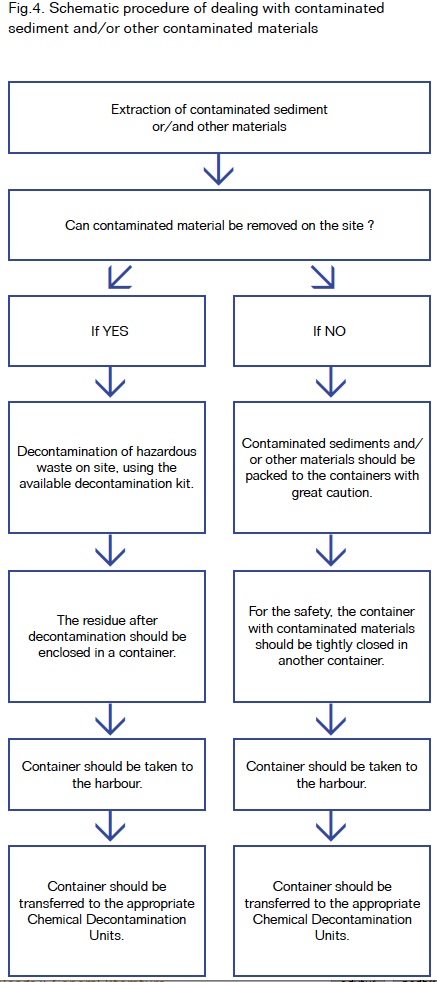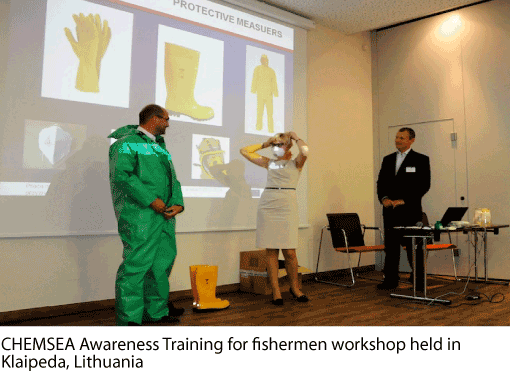 Both procedures for dealing with polluted sediments and safety recommendations regarding accidentally or deliberately fished CWA munitions are outdated and obsolete. Furthermore, they are regulated by a number of national legislations, as well as HELCOM recommendations and guidelines. This confusion has adverse consequences for safety of maritime operations.
Both procedures for dealing with polluted sediments and safety recommendations regarding accidentally or deliberately fished CWA munitions are outdated and obsolete. Furthermore, they are regulated by a number of national legislations, as well as HELCOM recommendations and guidelines. This confusion has adverse consequences for safety of maritime operations.
CHEMSEA carry out a review of existing national-level legislation regulating CWAs and developed updated and unified guidelines for:
As far as any type of munitions present a potential explosive or chemical agent hazard, they should not be moved, disturbed or handled. However, at sea and depending on the circumstances, precautionary actions may be required to protect the vessel and crew members. Therefore, in case of catch or extraction of hazardous or noxious substances of military origin, particularly CWA, a number of actions should be taken, which CHEMSEA has clarified in its Guidebook for Fishing Boat Crews and which distinguish cases in which the munition has been recovered but not brought on board vs. cases when it was brought on board. Guidelines also specify what should be done if any crew member comes into contact with CWA and in case of eye irritation.
BROCHURE: Code of Practice on Chemical Munition: A Guidebook for Fishing Boat Crews (English / Polish)
GUIDEBOOK: Dumped Chemical Munition: A Guidebook for Fishing Boat Crews (English / Polish)
STICKER: Procedures in case of chemical ammunition fish or picking up chemical ammunition (English / Polish)
In order to effectively manage hazardous waste (contaminated sediments, fish, etc.), all stakeholders, crews of fishing vessels and offshore companies operating on the seabed should follow three basic principles:
1. MINIMIZE EXPOSURE
Take all necessary precautions when working with contaminated sediments and other materials. As a means of minimising potential exposure, do not touch anything with bare hands and do not breathe vapours.
2. DO NOT UNDERESTIMATE RISKS
Ensure that the risk associated with each sample of contaminated sediment or other material is assessed, understood and communicated to the appropriate personnel. It is very important to assume that all contaminated sediments and other materials are very dangerous and that they should be handled with great caution.
3. USE PROPER COUNTERMEASURES
The use of personal protective equipment, and limitation of protection it offers, together with proper administrative procedures should be understood by all users. Ensure that all staff are properly trained in accordance with regulatory requirements so that they can perform their tasks safely.
The following are key management issues for handling contaminated materials, including sediments. Regulations regarding the proper storage of hazardous materials are complex. The schematic procedures for dealing with contaminated sediments are shown in figure below:

Different methods for treating and handling sediments are currently being developed. They include isolating the contaminants from the rest of the sediments by separating the smallest grains (since contaminants tend to stick to them) and separating the oily part of the sediment (which contains most of the toxic organic compounds). Sometimes sediment is incinerated in order to destroy organic contaminants. Other times, setting agents such as cement are added to solidify the sediment and prevent contaminants from being released into the environment. Bacteria and fungi may also be added to break down the contaminants; this process is called bioremediation.
CHEMSEA proposes two strategies for dealing with contaminated sediments and/or other materials. The first strategy is based on the knowledge and available equipment possessed by the interested companies and the ship’s crew. In this strategy, the contaminated sediments and/or other materials are disposed of on site. This strategy is only possible when workers and the vessel’s crew are properly trained and possess appropriate equipment for decontamination. In this situation decontamination of the sediments and/or other materials can be carried out on site, but can only be performed by qualified personnel!!! After decontamination, all sediments and/ or other materials should be sealed in containers and delivered to the harbour. Extraction and decontamination of sediments and/or other materials should be reported to the appropriate regional and/or national authority. The residue present after decontamination should be passed on to the unit responsible for chemical retrieval (Chemical Decontamination Unit).
The second strategy applies to the company employees, ship crew and other personnel who do not possess proper equipment and/or proper training to conduct decontamination of sediments and/or other materials. All operations performed on contaminated sediments and/or other materials must be done with extreme caution!!! Contaminated sediments and/or other materials should be packed in sealed containers. All operations involving the sealing of containers with contaminated sediments should be performed wearing protective gloves. Vapours from contaminated sediments and/or other materials should not be inhaled. Containers with contaminated sediments and/or other materials should be tightly closed in a second container and must then be delivered to the harbour. Extraction of contaminated sediments and/or other materials should be reported to the appropriate regional and/or national authority. The contaminated sediment and/or other materials should be passed on to the unit responsible for the chemical retrieval (Chemical Decontamination Unit).
Offshore-industry operations carried out in the Baltic Sea, particularly in areas close to CWA dumpsites, require that worst-case scenarios be anticipated. Specifically, it is probable that sludge extracted from the Baltic seabed could contain extremely hazardous CWA, e.g. Sarin or Tabun. The worst-case scenario leaves no time for deliberations of what should be done with a CWA hazardous find. When discovering a dangerous chemical from the group of organophosphoric compounds in the excavated sediments, actions must be taken immediately.
Therefore, guidelines on methods and techniques for destruction or decontamination of CWA hazardous compounds in place were reviewed within the CHEMSEA framework in the perspective of agents dumped in the Baltic, and the state they might be in, to support decontamination operations. CHEMSEA collected and described the main reactive systems for decontamination of all types of chemical warfare agents.
 In addition to focusing on national contingency plans and unified reaction models against CW threats, CHEMSEA conducted research to evaluate the level of awareness of working groups that may potentially come in contact with CW. This primarily included fishermen and offshore industry employees.
In addition to focusing on national contingency plans and unified reaction models against CW threats, CHEMSEA conducted research to evaluate the level of awareness of working groups that may potentially come in contact with CW. This primarily included fishermen and offshore industry employees.
Despite the existence of national plans concerning trainings for fishermen and offshore industry employees, CHEMSEA disclosed negligence in the implementation of such trainings. As this confusion has adverse consequences for the safety of maritime operations, an independent Awareness Training Program was prepared and conducted in Baltic States to spread knowledge on chemical munitions dumped at sea and to introduce best practices in minimising the threats posed by CWA.
The primary target group addressed by the CHEMSEA Awareness Trainings were fishermen. CHEMSEA cooperated closely with local fishermen’s associations and organised a number of trainings for fishermen in harbours, e.g. trainings in Hel, Władysławowo, Krynica Morska (Poland), Klaipeda (Lithuania), and Helsinki (Finland). Information delivered during the trainings included:
The main part of each awareness training focused on measures to be taken onboard in order to secure crew members in case of contact with CW at sea.
© CHEMSEA, IOPAN - wszelkie prawa zastrzeżone
Projekt i wykonanie - Virtual Services | Test zgodności W3C: HTML
Powered by: 